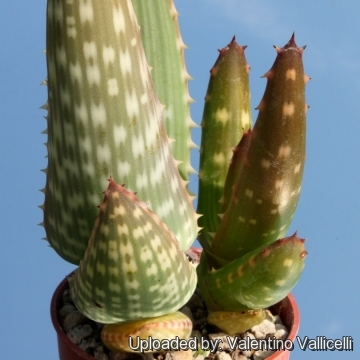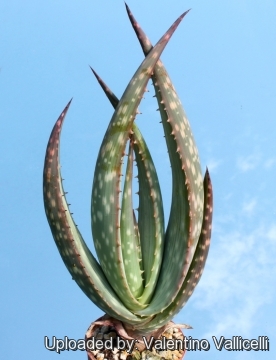




Your support is critical to our success.
Accepted Scientific Name: Aloe gariepensis Pillans
S. African Gard. 23: 213. 1933

Origin and Habitat: This species is found in fairly large numbers in Namibia and the Northern Cape. Aloe gariepensis is appropriately named because its natural distribution closely follows the Northern Cape Province river Gariep, the Khoisan name for the Orange River.
Type locality: Namibia, near Warmbad.
Altitude: 150 to 800 m above sea level.
Habitat: It grows on both banks of the Orange River, from near the mouth to Kakamas often inside the protection of rock crevices and small bushes or shrubs on steep slopes close to the river in the driest part of its course. In some localities it occurs in small pockets of sandy soil on rocky outcrops. Seeds germinate often in the shade of small nursery plants until strong enough to withstand the harsh conditions of the desert. Mature specimens are very robust and can handle several years of drought. A completely incurved red-coloured rosette is a sign of drought and sun stress and allows Aloe gariepensisSN|616]]SN|723]] to protect its tender growth tip. When whether return favourable, the rosette opens again allowing active growth. The eastern form of this species is much more robust than the type. It is locally abundant and therefore not threatened. Flowers are pollinated by sugar birds as well as winged and crawling insects. Other succulent plants found in this area comprises: Aloe melanacanthaSN|616]]SN|12205]], Aloe clavifloraSN|35308]]SN|14425]], Aloe falcata, Aloe pearsoniiSN|14425]]SN|35308]], Aloe dichotomaSN|12205]]SN|616]], Aloe dichotomaSN|723]]SN|616]] subsp. ramosissima, Aloe arenicola, Tylecodon paniculatusSN|33415]]SN|33415]], Cyphostemma juttaeSN|11031]]SN|11031]] and Cotyledon orbiculataSN|492]]SN|492]].
Synonyms:
- Aloe gariepensis Pillans
- Aloe gariusiana Dinter
ENGLISH: Gariep aloe
AFRIKAANS (Afrikaans): Gariepaalwyn
Description: Aloe gariepensisSN|694]]SN|723]] is a small to moderate sized rosette-forming succulent with characteristic white striped leaves. In stressed times (cold, drought) plant can become a fire red in colouration.
Habit: Aloe gariepensisSN|723]]SN|723]] is usually solitary, but groups are not uncommon, and vary in size, from small and stemless to larger, up to 1 m high, with a short erect stem. It form a dense rosette of sword-shaped leaves that often curve inward, especially during hot and dry conditions.
Leaves: Lanceolate, triangular, slender, circularly arranged around the base of the plant, flattish and curved upright 25-50 cm long, 50-90 cm wide, pale green, dull green or reddish brown, with or without linear white spots running longitudinally on both sides when young, and prominent, ornamental stripes when older. Margins horny with stiff reddish-brown triangular teeth 2–3 mm long.
Inflorescence: Racemes, 3 to 5 simultaneously from the same rosette, simple, very dense, cylindric to conical, 80-120 cm tall. Peduncle with narrow, stiff sterile bracts 17-26 mm long, 6-8 mm broad, 5-7-nerved. The floral bracts hide the young buds almost entirely. The racemes are yellow to greenish-yellow, or sometime the buds are red and the open flowers yellow, giving an attractive bicoloured effect.
Flowers: Simple, usually yellow both in bud and at flowering, rarely brick-red, 16-27 mm long; pedicels 12-20 mm long, lengthening to about 25 mm in fruit. Anthers exerted 1-5 mm. Ovary 4-5 mm long, 1,5-2 mm in diameter, green; style exerted 3-6 mm.
Blooming season: In mid-winter to early spring appear the unbranched inflorescences and flower open in pring (July to September in southern hemisphere)
Fruit: Loculicidal capsule, 14-16 mm long, 8-9 mm broad, yellow-brown. After fertilisation, the capsules grow quickly and split into 3 parts at the end of the summer.
Seeds: 4-5 mm long, 2 broad, 1 mm thick, black with pale transverse wings at each end, enabling them to be dispersed by the wind.
Remarks: Aloe gariepensisSN|723]]SN|723]] distinguish from the similar but much-branched, shrubby Aloe succotrinaSN|723]]SN|694]] for the the leaf sap that does not dry purple, with the result that dried leaves are not this colour.
Bibliography: Major references and further lectures
1) Urs Eggli “Illustrated Handbook of Suculent Plants: Monocotyledons” Springer, 2001. Pages 114-115
2) Susan Carter, John J. Lavranos, Leonard E. Newton, Colin C. Walker “Aloes. The definitive guide” Kew Publishing, Royal Botanic Gardens, Kew 2011, ISBN 978-1-84246-439-7, S. 251.
3) Court, D, 1981. “Succulent flora of Southern Africa” Balkema, Cape Town.
4) Cowling, R.& Pierce, S, 1999. “Namaqualand. A succulent desert” Fernwood Press, Cape Town.
5) Germishuizen, G. & Meyer, N.L. (eds) 2003. “Plants of southern Africa : an annotated checklist.” Strelitzia 14. National Botanical Institute, Pretoria.
6) Jackson, W P U, 1990. “Origins and meanings of South African plant genera” UCT Ecolab, Cape Town.
7) Antje Burke “Wild flowers of the southern Namib” Namibia Scientific Society, 2003
8) Gordon D. Rowley “The illustrated encyclopedia of succulents” Crown Publishers, 01/Aug/1978
9) Leistner, O.A. 2005. “Seed plants of southern tropical Africa” SABONET, Pretoria.
10) Nichols, G. 2005. “Growing rare plants, a practical handbook on propagating the treatened plants of southern Africa” Southern African Botanical Diversity Network Report No. 36. SABONET, Pretoria .
11) Reynolds, G.W. 1950. “The aloes of South Africa” The Aloes of South Africa Book Fund, Johannesburg.
12) Van Jaarsveld, E., Van Wyk, B-E. & Smith, G. 2000. “Succulents of South Africa” Cape Town , Tafelberg
13) Van Wyk, A.E. & Smith, G. 2001. “Regions of floristic endemism.” Umdaus Press, Hatfield.
14) Williamson, G. 2000. “Richtersveld. The enchanted wilderness” Umdaus Press, Hatfield.
15) Hans Bornman, David S. Hardy “Aloes of the South African veld” Voortrekkerpers, 1971
16) Barbara Jeppe “South African aloes” Purnell, 1974
17) Ben-Erik Van Wyk, Gideon Smith “Guide to the Aloes of South Africa” Briza Publ., 1996
18)
19) Stearn, W.T. 2003. “Stearn's dictionary of plant names for the gardener” Cassel, UK.
20) Smith, C.A. 1966. “Common names of South African plants.” Memoirs of the Botanical Survey of South Africa No. 35.
21) Van Wyk, B.-E. & Gericke, N. 2000. “People's plants. A guide to useful plants of southern Africa” Briza Publications, Pretoria.
22) Van Wyk, B-E. & Smith, G. 1996. “Guide to the aloes of South Africa” Briza Publications, Pretoria.
23) “Aloe gariepensis” Pillans in: South African Gardening and Country Life 23: 213 (1933a); Reynolds: 400 (1950); Jeppe: 32 (1969); Soldi, Roessler & Merxm.: 16 (1970); Bornman & D.S.Hardy: 217 (1972); I.Verd.: t. 1654 (1972); Jankowitz: 28 (1975); B.-E. van Wyk & G.F.Sm.: 172 (1996).

Aloe gariusiana (Aloe gariepensis) Photo by: Valentino Vallicelli

Aloe gariusiana (Aloe gariepensis) Photo by: Valentino Vallicelli
Cultivation and Propagation: It is relatively easy to cultivate under a wide variety of climatic conditions provided it is planted in a well-drained situation given adequate water but not over-watered.
Soil: Grow it in an open sandy-gritty well-drained cactus compost.
Pots: It needs a relatively shallow pot to accommodate its fibrous roots and provide a very good drainage. It may stay in the same pot for many years.
Watering: Water in moderation. Keep dry in winter or when night temperatures remain below 10° C. Water it less than average if in bigger pots.
Special need: Provide very good ventilation. Nearly all problems occur as a result of overwatering and poor ventilation, especially when weather conditions are dull and cool or very humid.
Fertilization: Light fertilizer seems to boost its growth whenever additional water is given.
Feed them during the growing season with a fertilizer specifically formulated for cactus and succulents (high potash fertilizer with a dilute low nitrogen), including all micro nutrients and trace elements diluted to ½ the strength recommended on the label. They thrive in poor soils and need a limited supplies of fertilizer to avoid the plants developing excess vegetation, which is easily attacked by fungal diseases.
Exposure: It enjoys light-shade. It may be grown in full sun too but protect in summer from afternoon sun, and avoid reflected heat. It will do its best with some sun and become stressed with inadequate light which could result in poor growth and unnatural shape. Direct sunlight along with prolonged drought and make the leaves turn a reddish colour, a sign generally associated with stress.
Hardiness: It likes warmth (recommended minimum winter temperature 5° C) however plants kept perfectly dry can can survive low temperatures, approx. -2° for short periods, but for safe cultivation it is best to avoid freezing temperatures.
Pest and diseases: Occasionally these plants are infested by scale and aphids, but all known garden pests can be kept to a minimum by simply ensuring optimal growing conditions and healthy plants.
Use: This is suited for a non heated green house. It can be also cultivated outdoors in raised beds, terraces if sheltered from winter rain. This aloe continues to be, a particular prize among collectors
Maintenance: Removal of old flower stalks.
Propagation: Propagation is by seed, as it usually do not offsets. Seeds must be sown as fresh as possible. The best time for sowing would be in the late summer before winter sets in when temperatures are still warm. Use coarse, well-drained sandy soil and cover seeds lightly, then keep moist. Cover the seeds with a fine layer of grit and water from below with a with a long-lasting fungicide, as seedlings are prone to damping off, a fungus that eventually kills the young plants. For the 1-2 weeks cover the pots with a sheet of glass/clear perspex to keep the humidity levels high. Remove the glass and replace it with light shade-cloth and mist once or twice a day for the next two weeks after which most seeds should have germinated. From then on mistings can be reduced to every second and then every third day as the little plants grow. After germination, when plants are about 20–30 mm high, re-plant seedlings using a sandy loam medium and feed with organic fertilizer at least once a quarter to ensure healthy growth. If you have a number of them you could intentionally damage the growing point to see if it will offset, but wait to do that until early spring, when its growing season is beginning.
| Your Actions | |
|---|---|
| Back to Aloe index | |
| Back to Aloaceae index | |
 |
Back to Succulents Encyclopedia index |
Privacy stantement - Terms and conditions - How to cite - About us - Feedback - Donate




